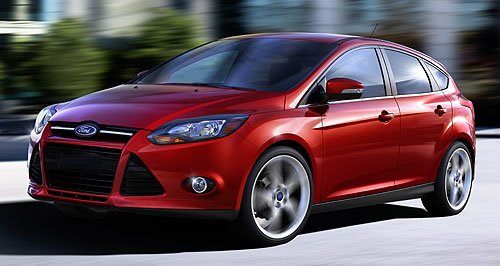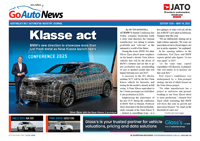Future models - Ford - Focus - Hatch and sedan rangeFirst drive: Ford sets Focus on smallIn focus: Ford's 2012 Focus has launched in the US and arrives here in about six months. We drive Ford’s most important car since the Model T, the third-generation Focus31 Jan 2011 By MARTON PETTENDY in LOS ANGELES FOR the world’s third largest car-maker, the global automotive industry as a whole and Blue Oval small-car fans everywhere, it is difficult to understate the importance of Ford’s third-generation Focus. Due in Australian showrooms during the third quarter of this year in both five-door hatchback and four-door sedan body styles, the MkIII Focus – a nameplate that has attracted 10 million customers since 1998 – is more than just a litmus test for the US company’s One Ford global product strategy. The next Focus replaces a model whose dynamic prowess was matched by its stellar sales success in Europe and rides on an all-new platform that, instead of being shared with Mazda’s 3, will underpin 10 new small Ford global models with 80 per cent parts commonality. Australia's version was at one stage to have been built at Broadmeadows but now will be sourced initially from Ford’s Saarlouis plant in Germany before production for Australia switches to a new Thailand plant in 2012. The replacement for Ford’s top-selling model is now also being built in North America and, soon, Russia and China for sale in 122 nations. Once all 10 model derivatives are on sale, Ford estimates it will produce two million C-platform vehicles a year by 2012 – double the number in 2008. Production of Australia’s MkII Focus, released here in June 2005, ends in South Africa soon and, although replacements for the three-door hatch and coupe-convertible are not in the pipeline, the MkIII Focus range will comprise five-door hatch, sedan and wagon variants. First shown at last year’s Detroit motor show and now in production at Ford’s Michigan assembly plant, the redesigned Focus represents the Blue Oval's most serious tilt at similarly global small cars like Toyota’s top-selling Corolla and the Mazda3. In preparation, Ford used this week’s global launch of the Focus in Los Angeles – where GoAuto sampled both hatch and sedan versions in peak-hour city, freeway and mountainous backroad environments – to tout the car’s new level of quality, refinement, efficiency, performance and technology. Among a host of firsts for the new model is a bodyshell that is claimed to be 30 per cent more rigid than before, due to the fact more than half of it (55 per cent) will be made from high-strength steel. As well, 26 per cent of the vehicle is made from ultra-high-strength steel, including Boron – more than any other Ford model. The result is vastly improved noise, vibration and harshness (NVH) levels – including interior wind noise that Ford claims is much lower than in rivals such as the VW Jetta and Mazda3 – making the new Focus feel like a mini-Mondeo in terms of interior quietness and ambience. The fully independent Control Blade multi-link rear suspension assembly famously pioneered by the original Focus back in 1998 is now attached to the chassis by a separate sub-frame, also reducing road noise. Of course, the latest interpretation of Ford’s ‘kinetic’ design language not only makes both the lower, longer and wider hatch and sedan models look more upmarket than before, but results in an aerodynamic drag coefficient of as low as 0.297Cd for the sedan, which according to Ford makes it slipperier than both the Jetta and Holden’s Cruze. Also contributing to an alleged seven per cent improvement in aero efficiency are under-body panels and a new BMW-style active grille shutter system, which blocks cooling airflow when not required to improve aerodynamics at higher speeds and reduce engine temperatures at low speeds. Australia’s Focus will launch with two direct-injection 2.0-litre four-cylinder engines – a Duratorq turbo-diesel and a Ti-VCT petrol – matched with both five-speed manual and six-speed dual-clutch Powershift automatic transmissions. The latter is already found in the current Focus TDCi hatch, but will replace the conventional four-speed auto in other models. Later, the same 2.0-litre EcoBoost petrol four that will see duty in the Falcon this year will power next year’s Focus ST/XR performance flagship. It will replace the current Focus XR5's turbocharged 2.5-litre five-cylinder engine and will again be matched only with a six-speed manual gearbox.  Only the 2.0-litre petrol four – North America’s staple engine – was made available at the launch, where it delivered adequate but not startling performance with outstanding smoothness and quietness all the way to its 6500rpm redline. Only the 2.0-litre petrol four – North America’s staple engine – was made available at the launch, where it delivered adequate but not startling performance with outstanding smoothness and quietness all the way to its 6500rpm redline.Base kerb weights for 2.0-litre petrol models increase by up to 50kg, with the five-door manual weighing 1310kg and the four-door auto weighing 1340kg. Although it is not noticeably heavier than before, the appreciably stiffer bodyshell gives 2012 Focus drivers a feeling of large-car solidity that is lacking in direct rivals like the Corolla and Mazda3. Despite this, and although our spirited drive resulted in fuel consumption of around 9.0L/100km, Ford says the 2.0-litre Focus is the only petrol-powered automatic small car to deliver highway fuel economy of just 40mpg (5.9L/100km). Along with reduced fuel consumption (Australia’s current Focus petrol manual officially uses 7.1L/100km on the combined cycle), peak power is up to around 119kW at 6500rpm (from 107kW) while maximum torque increases to about 198Nm at 4450rpm – from 185Nm, both at similar revs. The vastly improved dual variable valve timing petrol four matches well with the dual-clutch Powershift auto, delivering instant up and down shifts via the somehwhat fiddly new thumb-shift buttons on the side of the gearshift knob. Sadly, however, the VW DSG-style automated manual can be lazy in drive mode, lacks steering wheel shift paddles and does not permit full override even in manual mode. Ford says the 2012 Focus’ chassis and suspension tune – including the new Porsche-style Active Torque Vectoring system that brakes individual driven wheels to improve traction and provide a form of electronic limited-slip differential – will be almost identical across all markets and after driving it we think that’s a good thing. Riding on 16, 17 and 18-inch Continental tyres (the latter as part of the US market’s optional sports package) on California’s billiard table-smooth bitumen surfaces, ride quality was never less than perfect and initial impressions suggest the set-up should cope wellwith Australia’s lower quality blacktop. Pushing harder on the tight and twisty tarmac that weaves its way through the peaks and canyons east of Malibu, the entry-level Focus we drove did display some bodyroll and typical mid-corner front-drive understeer, but the sportier Titanium model variant offered an appreciably firmer (but no less plush) ride and, for a small car, body control in all models was always poised and polished. If there is a downside to the Focus’ new-found panache, however, it is steering. Few cars have made the transition from conventional hydraulic to electric power steering and it seems the Focus – a nameplate that has the enviable reputation of being one of the sharpest steering small cars ever – is no exception. Building on the rest of the car’s prestige feel, the Focus tiller is unaffected by the kickback, rack rattle and torque steer that afflicts many small cars and feels well weighted at both parking and highway speeds, where it offers an excellent straight-line ‘self-drive’. Unfortunately, however, the downside of the new EPAS steering system – which brings with it worthwhile fuel consumption reductions and a gimmicky but first-in-class automatic parallel parking function that parks the car in 24 seconds – lacks response off-centre and is almost totally devoid of feel and feedback, let alone the tactility and precision of its forebears. Yes, a brilliantly resolved ride/handling compromise and super-stiff bodyshell combine to make the Focus as agile as ever and its vice-free chassis will appeal to a much broader audience than ever before, but compared to its sharp-steering predecessors the latest Focus will be a let-down for enthusiasts. Let’s just hope the ST/XR and, perhaps, RS models to follow do not follow suit. Ford Australia will again offer a number of mainstream Focus model grades, culminating in the top-shelf Titanium variant which tops the range in the US, where S, SE and SEL versions are also now available. Ford describes its first global model as the most hi-tech Ford ever and says the 2012 Focus offers more affordable technologies than the Corolla and Honda’s Civic, as well as larger models like the Camry and Accord. Although Australia’s standard equipment list is likely to be more extensive across the board, in North America the entry-level Focus S sedan comes standard with electronic stability control, twin front, side and curtain airbags, air-conditioning, front power windows and a 110-Watt sound system with input jack. The Focus SE hatch adds MyKey programmability, automatic quad-beam halogen headlights, steering wheel audio controls, rear power windows, a rear spoiler, 60/40-split folding rear seatback and a rear windscreen wiper. Mid-range Focus SEL models gain two extra speakers, a rear 12-volt outlet, dual-zone climate-control, cruise control, ambient lighting in seven colours, and MyFord and Ford Sync USB connectivity, while the Titanium flagship adds sports-tuned suspension, 17-inch machined alloy wheels, keyless entry/starting, a 10-speaker Sony sound system, full leather trim and the new MyFord Touch system with piano black surround and eight-inch colourtouch-screen. The latter takes voice-activated audio, climate and navigation control to a new level in a small car – and also features a rear-view camera, Wi-Fi and text-to-voice capability, Bluetooth connectivity, two five-way steering wheel controls and an HD radio with iTunes tagging. Alas, the MyFord Touch system remains two years away from Australian shores, but the Fiesta-style push-button sound system on the cockpit-style centre stack in lesser Focus models still looks classy. Base models also do without the soft-touch door trims seen in the Titanium, but all variants offer a luxuriously soft animal skin-like dash surface, highly supportive sports seats with driver’s adjustment, and a high-end TFT info screen between the instrument dials. The cabin of Ford's latest Focus is as modern, upmarket and high-quality as the car's elegant new exterior, as well as being as ergonomic as a Golf and as high-tech as an Audi. Its rear seat still isn't as spacious as an Opel Astra's but, according to Ford, the Focus sedan affords more front headroom than a Camry, more front legroom and shoulder room than an Audi A4 and more rear headroom than both the A4 and Camry. We didn't like the cheap-looking matt-black lower door and bumper strips that adorn all models and some front occupants might find the V-shaped centre stack causes discomfort to the knee, but outstanding attention to detail, surprising touches like the one-touch lane-change indicators, capless fuel filler and decidedly German-sounding door-thud tend to make up for that. Electric steering might make the new Focus less fun to drive than before, but the new model improves on its accomplished predecessor in every other respect and now offers first-class ride, refinement and technology. Add to that an otherwise superb ride/handling package, impeccable design and build quality, class-leading petrol engine efficiency and handsome new exteriors and Ford’s newest small car is certain to attract far more fresh customers than it scares away.  Read more10th of January 2011  First look: Ford unveils all-new Focus ElectricFord to offer super-quick home recharging with Focus EV as production draws nearFocus pricing
Motor industry news |
Click to shareFord modelsResearch Ford Focus pricing
Motor industry news |
















Facebook Twitter Instagram